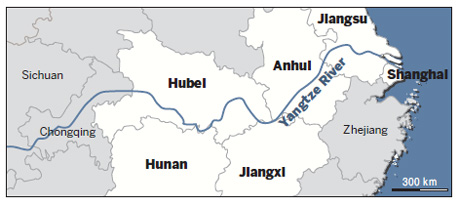Society
Birds still flocking to Yangtze wetlands
Updated: 2011-03-03 07:53
By Chen Liang (China Daily)

Another important sighting is that of more than 170 Baer's pochards in Hubei.
The diving duck breeds in Southeast Russia and Northeast China, migrating in winter to southern China, Vietnam, Japan and India. It is classified as endangered as its numbers are estimated to have declined between 50 and 79 percent from 1998 to 2008, with their global population now standing at 5,000, according to the BirdLife International website.
"Here (Wuhan) in one lake, we counted more than 110 of these birds," Lei says. "It's certainly an important finding for the bird's research and conservation."
Excited by the find, Lei and his colleagues went to the lake and counted the birds again after the survey to "double check the figure", he says.
For conservationists working with the East Dongting Lake National Nature Reserve in Hunan province, the winter survey in Dongting Lake, one of the important flood-basins of the Yangtze River and a wintering ground for waterbirds, is routine work.
"To be honest, we didn't really expect to make any special find," says Yao Yi, head of the reserve's research department, who was in charge of Hunan's survey.
He attributed the increase of birds recorded in Hunan to an expansion of surveyed areas and good weather on the two survey days.
"We used to just focus on Dongting Lake but this year we went to several upstream reservoirs," he says. "It's usually either foggy or raining in winter, making it difficult to count birds. But it was extremely nice weather on Jan 11 and 12, which certainly helped us see more birds."
More than 30 participants from four nature reserves in the province recorded 56 species among nearly 180,000 birds, he says. Of them, six species - bean goose, lesser white-fronted goose, greater white-fronted goose, falcated duck, common teal and Dunlin - numbered more than 10,000. The numbers of four species - lesser white-fronted goose, Eurasian spoonbill, bean goose and falcated duck - accounted for more than 1 per cent of their global populations.
Although construction of a dam on the lake, poplar trees encroaching on the flood basin and over-fishing are still threatening the waterbird habitats around the lake, Yao says, the population of waterfowl remains stable. "This is a better result than any sharp rise or fall," he says.
The situation is somewhat different in Jiangsu province. Although Wang Hui and 20 of his colleagues recorded 58 species among more than 180,000 waterbirds, he still worries about what he saw during the survey.
According to the research department head of Yancheng National Nature Reserve who was in charge of the survey in Jiangsu, they traveled more than 4,000 km to visit more than 20 sites in the province in mid-January and found much evidence of the sharp change of waterbird habitats.
At the estuary of the Chuhe River, there used to be hundreds of gulls and waders, but there was "not one bird this year", he says, "because of the construction of a harbor".
At Shanghu Lake in Changshu, he once recorded more than 10,000 black-crowned night herons and dozens of mandarin ducks, but saw none of them this year, due to widespread tourism development.
The water quality at some lakes, such as Yangcheng Lake, is still good. But intensive crab farming has left hardly any space for birds, Wang says.
Weather remains a factor that could influence the final count, he says. In November, 2010, his team recorded more than 110,000 waterbirds in and around Hongze Lake, the largest waterbird habitat in the province.
During their survey in January, however, they counted only about 30,000 birds there. The lake was frozen and this probably pushed more of the migrating birds to the south, he says. "In 2005, the lake wasn't frozen even in February."
While surveying areas around the Yancheng reserve, the world's largest wintering ground for endangered red-crowned cranes, he and his colleagues recorded 49 red-crowned cranes, more than 1,800 common cranes and 600 bean geese, in one day.
"They live not only within the reserve, but also in farming areas and reed fields outside," he says. "Spring plowing with poisonous fertilizers, paper-making that uses reed as a raw material, and construction of a power plant threatens their wintering in the region.
"The survey shows how close they live to us, how fragile they are, and how heavy our responsibility is to protect them."
E-paper

Sindberg leaves lasting legacy
China commemorates Danish hero's courage during Nanjing Massacres.
Crystal Clear
No more tears
Road to the Oscars
Specials

NPC & CPPCC sessions
Lawmakers and political advisers gather in Beijing to discuss major issues.

Sentimental journey
Prince William and Kate Middleton returned to the place where they met and fell in love.

Rent your own island
Zhejiang Province charts plans to lease coastal islands for private investments
